Finding the perfect toilet for your home may seem straightforward, but with countless styles, sizes, and features available, it can quickly become overwhelming. Whether you’re remodeling your bathroom or simply upgrading your current toilet, understanding your options is essential to making an informed decision.
In this guide to buying a toilet, we’ll walk you through everything you need to know—from size and shape considerations to flushing systems, installation types, and high-tech features. The right toilet not only enhances comfort and functionality but can also improve water efficiency and overall bathroom aesthetics.
Why Choosing the Right Toilet Matters
If you’re like most people, you don’t spend a lot of time thinking about your toilet. Your current toilet is likely a standard white two-piece unit—but with so many options available today, there’s nothing “standard” about any toilet.
A well-chosen toilet can enhance comfort, improve water efficiency, and even complement your bathroom’s aesthetics. Whether you’re going for a modern, minimalist look or pairing your toilet with Italian bathroom vanities, selecting the right model is essential. That’s why we’ve created this guide to buying a toilet, covering everything from size and style to flushing systems and special features.
What You Need to Know Before Selecting a Toilet
When it comes to buying a toilet, there are several practical factors to consider. Taking the time to evaluate these details can help you avoid costly plumbing adjustments and ensure you choose the right toilet for your space.
How far can a toilet be from the Soil Pipe, and where it is located
One of the first things to consider in this guide to buying a toilet is the position of the soil pipe and the layout of your bathroom. The location of your toilet will be influenced by where the soil pipe is, along with the surrounding fixtures and fittings. Typically, toilets need to be positioned within 6 meters of the soil pipe, although shorter distances are generally recommended for better efficiency.
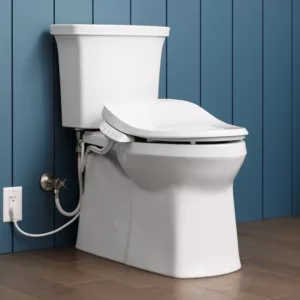
The soil pipe is responsible for carrying waste-water away from the toilet. It’s usually located outside the house as an exposed pipe running the full length of the home, often with a vent at the top. If it’s not visible, the pipe is likely concealed in the walls or attic. Before purchasing any fixtures—such as those from the Blues 4.0 bathroom collection—it’s advised to consult a plumber or installer to ensure compatibility with your existing plumbing system and to assess potential costs for any necessary changes.
Additionally, it’s crucial to understand the type of outlet your toilet will require. Toilets typically feature one of these outlets:
- Horizontal outlet: runs parallel to the ground with a slight incline.
- Vertical outlet: runs vertically behind the toilet.
- Left-facing outlet: exits the toilet to the left.
- Right-facing outlet: exits the toilet to the right.
Should you choose a wall-hung or floor-mounted toilet?
When deciding between a wall-hung or floor-mounted toilet, consider the type and strength of the wall where the toilet will be fixed. In this guide to buying a toilet, floor-standing toilets, like back-to-wall and close-coupled models, don’t require additional structural support, as their weight is distributed through the base. However, wall-hung toilets must be installed on a strong frame to support both the toilet and its user. For those looking to create a Hi-Tech bathroom, a wall-hung toilet can be a sleek, space-saving option. Just make sure the wall can handle the weight or consider building a faux wall if needed. Keep in mind that this option may take up extra space, affecting your bathroom’s layout.
How much space do you need for a toilet?
Most toilets have a projection of around 800mm or less, with a width of 600mm or less. Regardless of where the toilet is placed, ensure there’s enough room for comfortable sitting and easy access to other bathroom fixtures. For tight spaces, a short-projection toilet is a great solution, offering a more compact design that’s ideal for small rooms like cloakrooms or en suites.
For a modern and functional STK Nordic bathroom, consider space-efficient fixtures that maximize comfort without compromising style. If you’re replacing an existing toilet, use it as a reference for size. Otherwise, creating a floor plan or using a 3D bathroom design service can help you visualize the space and detect potential issues early.
Where should the toilet be positioned?
While toilets typically face perpendicular to the wall, you can also opt for corner toilets if space is limited. These models feature an angled cistern that fits into the corner of the room, making them a great space-saving choice.
Different Types of Toilet
Once you’ve considered the location, size, and practical aspects of toilet installation, it’s time to focus on the design that best complements the style or theme of your space. In the guide to buying a toilet, we break down each toilet type, how to identify them, and what features to look for.
Close coupled toilets
The close-coupled toilet is likely the most traditional and widely recognized style in a British family bathroom, familiar to most people. It features a floor-standing pan or bowl that is securely sealed, with an exposed cistern that is directly attached to the pan. Modern versions typically come with push buttons, while older designs may feature lever handles, although this isn’t always the case.
For those looking to upgrade to a sleek and contemporary Swing 4.0 bathroom, close-coupled toilets offer a balance of classic functionality and modern aesthetics. Depending on personal preference regarding exposed pipework, close-coupled toilets are available in two common styles:
Open back close coupled toilets
Open back close coupled toilets feature a pan with a gap at the rear, while the cistern is positioned flush against the wall. This gap allows for easy access to the pipework and simplifies maintenance.
Closed back/back to wall close coupled toilets
Closed back close coupled toilets, or back-to-wall models, have a cistern and pan that sit fully flush against the wall. This design conceals the internal pipework, eliminating the need to clean or reach around the back of the toilet. The result is a sleek, tidy look that blends seamlessly with the overall Zero Stone bathroom design.
Wall Hung toilets
A wall-hung toilet, also known as a floating toilet, is exactly as the name suggests: the bowl is mounted to the wall and suspended a short distance above the floor, with the cistern concealed within the wall and supported by a sturdy frame. Typically made from strong materials like steel, the frame is designed to bear the weight of both the toilet and the user. Wall-hung toilets are becoming increasingly popular because they free up floor space, making the room appear larger, while seamlessly blending into the design without exposing any pipework or fittings. Among various toilet bowl types, wall-hung models are often chosen for their sleek, modern look and space-saving benefits. Additionally, they come in different toilet bowl shapes, allowing homeowners to select a design that best suits their bathroom’s aesthetic and comfort preferences. For those looking for a stylish and modern upgrade, an XS Color bathroom setup with a wall-hung toilet can provide a perfect blend of functionality and design.
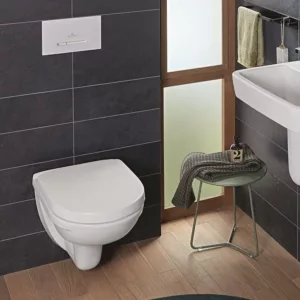
Frames come in different sizes, allowing you to adjust the height of the toilet to suit your needs, and they are also exceptionally easy to clean, both directly and around the base.
Back to wall toilets
Firstly, it’s important not to confuse back-to-wall toilets with close-coupled toilets. While both feature a pan that sits flush against the wall, they differ in design.
Back-to-wall (BTW) toilets, however, have a concealed cistern, similar to wall-hung toilets. Since the weight is supported through the floor, they don’t require a frame. That said, the height of the cistern must be considered, as it could either be a standard-size cistern or a taller version for toilets with an extended height.
Here are a couple of benefits of back-to-wall toilets:
- Ideal for tight spaces, as they can be integrated into bathroom furniture or walls, and even combined with a basin and storage in a single unit.
- The concealed cistern creates a streamlined, sleek visual design.
Low level, medium level and high level toilets
Toilets generally fall into either modern or traditional designs, but some models are specifically crafted to reflect a period-style aesthetic, making them perfect for Edwardian, Georgian, or Victorian-inspired spaces. These toilets are similar to close-coupled models, but instead of a cistern bolted directly to the pan, they are connected by a pipe and typically wall-mounted with brackets. These are referred to as Low-Level, Medium-Level, or High-Level Toilets. The names indicate the height and positioning of the cistern, as well as the length of the connecting pipe. Low-level toilets are positioned closer to the pan, while high-level toilets can reach up to 2 meters, or even to ceiling height. As a result, high-level toilets typically feature a pull-lever and chain flush, while the lower models are usually operated with a push button or lever handle.
Here are a few benefits of traditional toilets:
- The ability to adjust the cistern height allows you to control the aesthetic of your bathroom.
- These designs add a unique, historical charm to any bathroom aiming for a period look.
- The elevated cistern makes it harder for people to tamper with the flushing mechanism.
The Types of Flush to Have
Toilets are available in single-flush or dual-flush options, with the latter becoming increasingly popular as more people prioritize water conservation and environmental awareness. Single-flush toilets typically operate with a single push button or lever handle, while dual-flush models are usually equipped with a flush plate or button featuring two separate buttons. The larger button activates a “full flush” using 6 liters of water, while the smaller button triggers a “half-flush” using 3 or 4 liters. Some toilets, along with their frames, can be adjusted to use even less water, such as 4.5 liters, which is worth considering if saving water—whether financially or environmentally—is a priority for you.
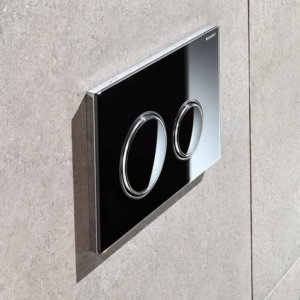
In addition to the flush type, certain toilets come with upgraded flush mechanisms that enhance bowl rinsing efficiency. Examples include the DirectFlush and Twist Flush systems from Villeroy & Boch, as well as other variations like cyclone flush.
Choosing the Right Toilet Style
The type of toilet often determines its overall style, especially in the case of wall-hung toilets, which are almost always designed with a modern aesthetic. However, for close-coupled and back-to-wall toilets, the choice of style becomes more flexible.
Beyond style, it’s essential to take size and design features into account when selecting a toilet.
Modern toilet or traditional?
Modern toilets typically feature sleek, streamlined shapes with either angular or gently curved designs. They are often paired with a soft-close toilet seat, available in wrap-over or sandwich styles, enhancing both comfort and functionality.
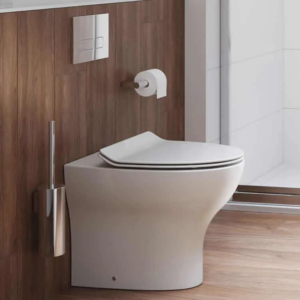
Traditional toilets often feature more exposed fittings, giving them a classic, vintage appeal. The accompanying toilet seat can be either standard or soft-close, with options beyond the typical white finish, including rich wooden tones or other colors. The pans are typically more ornate, incorporating intricate curves and pedestal-like designs. Additionally, these toilets usually operate with a lever-handle or pull-chain flush, enhancing their period-style aesthetic.
Size & shape
The first thing to consider when choosing a toilet is the size and shape, and how much space it will take up for your bathroom design. As outlined in this guide to buying a toilet, toilets generally come in one of three bowl shapes: elongated, compact elongated, and round. The elongated toilet is very common and often considered more comfortable, while the round toilet is smaller and typically better suited for bathrooms dedicated to children or tight spaces.
The elongated toilet can measure up to 31” from the wall and the round toilet is usually not more than 28” from the wall.
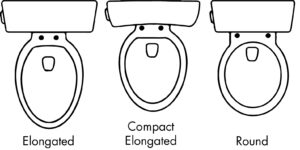
The three basic toilet bowl shapes.
Tip: Measure your bathroom to determine if the toilet you like will fit.
The standard height of a household toilet is between 14” and 15” tall. However, when considering toilet shapes and sizes, it’s important to note that the Americans with Disabilities Act mandates that toilets should be at least 16.5” tall. You don’t have to choose an ADA compliant toilet for your home, but you may find that a 15” toilet feels small to you because you’ve gotten used to the higher public toilets. Comfort height toilets come up to 19” tall, which is roughly the same height as your dining room chairs and makes it easier for seniors or people with back problems to sit down and stand up. Additionally, when selecting a toilet, it’s essential to explore the different shapes of toilet seats to ensure the perfect fit and maximize comfort.
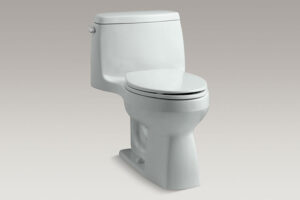
Tip: Consider both who will be using the toilet in the short run, and who might use the toilet in the long term when deciding how tall of a toilet you want.
Wall-mounted or free-standing?
A good way to narrow down the list of possible toilets for your home is to decide what type of toilet you’d like. There are three types of toilets: one-piece, two-piece, and wall-mounted. The two-piece toilet is by far the most ubiquitous type of toilet. While the tank is designed to fit the bowl, there is always some kind of seam between that can be difficult to clean. The classic one-piece toilet has the same looks almost identical to the two-piece but integrates the tank and bowl into a single seamless design, which makes cleaning easier and saves space.
While the tank is designed to fit the bowl, there is always some kind of seam between them that can be difficult to clean.
In a Modern Bathroom, a one-piece toilet is often preferred for its sleek and seamless design. Unlike the two-piece, it integrates the tank and bowl into a single unit, making cleaning easier and saving space.
Wall-mounted toilets are also gaining popularity for their minimal footprint and stylish look. These toilets, like those found in an Onda Bathroom, either have a tankless design or conceal the tank behind the wall. Installation is more complicated, but the toilet takes up a lot less space and is easier to clean. There are also floor-mounted tankless toilets, like the Kohler Veil. These toilets are slightly more classic in look, but with all the benefits of a wall-mounted toilet.
There are also floor-mounted tankless toilets, like the Kohler Veil, which offer a more classic look with the same space-saving and easy-cleaning benefits as a wall-mounted option. If you’re looking for a modern and space-efficient option, considering wall-mounted toilets is essential in any guide to buying a toilet.
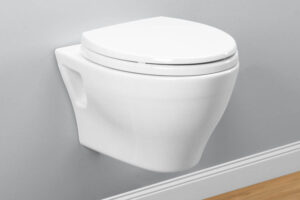
Tip: Consider the style of your home. A wall-mounted or floor-mounted tankless toilet looks fantastic in a modern bathroom but would be inappropriate in a very traditional bathroom.
Flushing systems
A key factor in any guide to buying a toilet is understanding the different flushing systems available. The average toilet is flushed around 2,000 times per year, making efficiency an important consideration.The average toilet gets flushed around 2,000 times per year. Before 1994, the average toilet required 3.5 gallons of water per flush—that is literally a lot of water and money down the drain. Toilets manufactured after 1994 most likely require 1.6 gallons of water to flush. EPA WaterSense labeled toilets use at least 20% less water than the current federal standard of 1.6 gallons, and modern dual-flush technology means you use as little as .6 gallons of water per flush.
There are two types of flushing systems. Toilets in private homes generally use a gravity flushing system, which uses the force of gravity to empty the bowl. The benefit of gravity flushing is that the toilet has fewer moving parts, which means repairs are less likely and less expensive.
Some manufacturers like Toto have come up with a variety of branded gravity-assisted flushing systems. Don’t worry so much about the technical aspects of how the toilet flushes but rather defer to reviews of any toilet you’re considering purchasing to see if it’s living up to the manufacturer’s promises.
The other option is a pressure-assisted flush system, which uses air pressure to empty the bowl. The benefit is, clogs are less likely, but with more moving parts, pressure-assisted flush toilets can be very noisy and may need more maintenance. Also, not all plumbing configurations can accommodate a pressure-assisted toilet—you may want to check with your plumber or contractor before making your purchase.
Tip: Consider how much use traffic the toilet will get—and make sure the toilet you choose carries the WaterSense label!
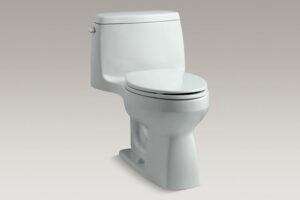
The Toto Drake II two-piece toilet with Double Cyclone technology is consistently rated one of the best flushing toilets on the market.
The act of flushing
As you dive into this guide to buying a toilet, it’s important to understand that there are differences not only in how a toilet flushes but also in how it is flushed. There are differences not only in how a toilet flushes but in how it is flushed. The two main options are the push-button and the lever. The button has a little sleeker look but the lever is usually less expensive. They both function equally well.
Touchless toilets are also increasingly popular. Just wave your hand over the sensor, and the toilet will flush. Great for minimizing germs in the bathroom, especially in a powder room that gets a lot of guest traffic.
Tip: Kohler makes a Touchless kit that can convert almost any other toilet.
Concealed and skirted toilets
As you follow this guide to buying a toilet, consider the design and cleanliness of the toilet. Most classic toilet designs have an exposed trapway, which features rounded corners and edges that easily collect dust and are difficult to clean. Most classic toilet designs have an exposed trapway, which has a lot of rounded corners and edges that collect dust and can be hard to keep clean. Now many manufacturers are designing toilets with a concealed trapway, which is a smooth surface at the back of the toilet, or a skirt, which offers a clean line all the way around the base of the toilet. Both concealed trapways and skirted toilets have a sleeker look and are much easier to keep clean.
Toilets with a skirt or a concealed trapway are installed in a couple of different ways, some attach to a porcelain piece that is bolted to the floor while others make the attachment points accessible at the very back of the toilet. Some skirted toilets that cover the rear of the toilet as well have a skirt that extends very close to the back wall, which can interfere with the supply line of the toilet. Supply lines can be moved, but it’s an expensive job.
Tip: Check the toilet’s spec sheet to make sure your supply line will work with a skirted toilet.

The Kohler Veil Intelligent skirted dual-flush toilet is one of the sleekest floor-mounted toilets on the market.
Color
We haven’t run the numbers, but we’re willing to hazard a guess that 95% of all toilets are some shade of white. Why? Well, for one, they’re easier to match and look appropriate in just about any style of bathroom, including Contemporary Bathrooms. White is also modern and classic at the same time, while “fun” colors like red and blue can make even a new bathroom appear dated, and can be a minus to potential buyers should you choose to put your house on the market. Also, it’s a lot easier to see when a white toilet needs to be cleaned.
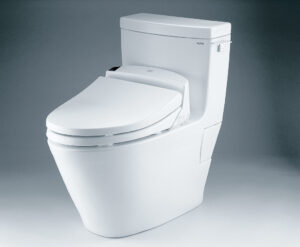
If the style of your bathroom is ultra-modern, you may consider black or stainless steel, but the higher cost aside, even these colors should be used sparingly.
Tip: When it comes to toilet color, it’s best to keep it conservative.
Space-age extras
Have you heard about the toilets in Japan? With their heated seats, built-in bidets, blow dryers, and motion sensors? The secret to these toilets is actually in the bidet-style seat. The first modern Japanese toilet was the Toto Washlet G, introduced in 1980. The term “washlet” is technically trademarked by Toto but is now used colloquially to refer to any bidet-style toilet seat.
While the Googleplex is famous for their fancy toilets, bidet-style toilet seats are slow to catch on, anyone who’s had the chance to use one generally raves about them. Also, the bidet and built-in dryer can save a lot of toilet paper—good for the planet and good for your wallet.
A version of Toto’s Washlet toilet is available in the US, and other manufacturers have slowly been releasing their own versions.
Tip: San Francisco-based Brondell offers a variety of bidet-style toilet seats that can be installed on any conventional toilet.
Conclusion
When choosing the best toilet for your home, there’s a lot to consider beyond just the basics. From selecting the right European toilet bowl shapes that fit your space to understanding the various flushing systems and modern design options, finding the ideal toilet depends on your personal needs and preferences. Whether you prioritize comfort, functionality, or aesthetics, it’s essential to factor in elements like the size of the toilet, the flushing mechanism, and the ease of cleaning. With the right knowledge, such as what we’ve covered in this guide, you’re well-equipped to make a confident decision that suits your home and lifestyle.



